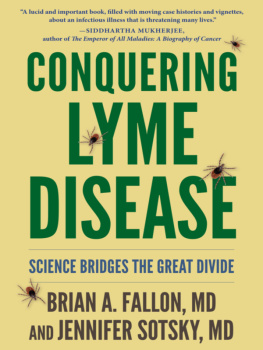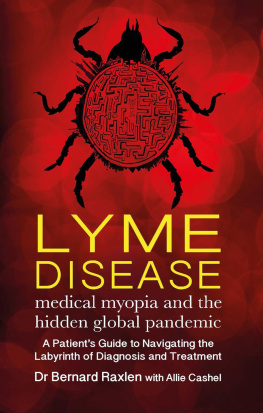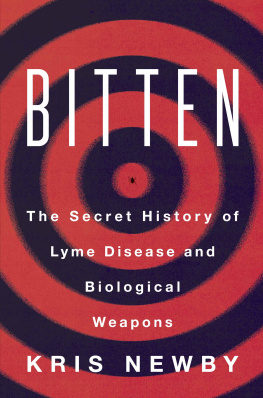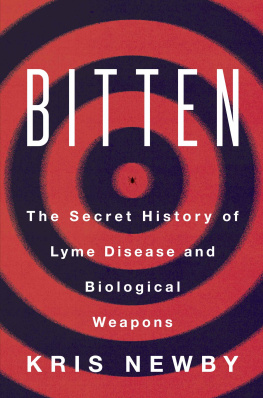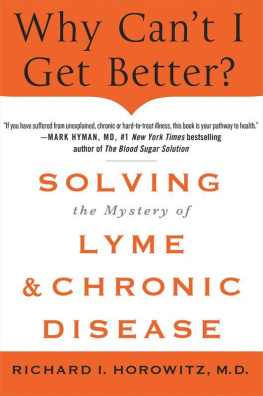Table of Contents
CONQUERING LYME DISEASE
CONQUERING LYME DISEASE
Science Bridges the Great Divide
Brian A. Fallon, MD, and Jennifer Sotsky, MD
with Carl Brenner, Carolyn Britton, MD, Marina Makous, MD, Jenifer Nields, MD, and Barbara Strobino, PhD
COLUMBIA UNIVERSITY PRESS
NEW YORK
The information in this book is not a substitute for medical evaluation or advice. If you are concerned that you might have Lyme disease or any other illness, please consult with a physician for a thorough evaluation and treatment plan.
Case histories in this book are either drawn from the published literature or represent fictionalized accounts drawn from our combined experiences with numerous patients.
All royalties from the sale of this book go to the Research Foundation for Mental Hygiene to support research at the Lyme and Tick-borne Disease Research Center.
Columbia University Press
Publishers Since 1893
New York Chichester, West Sussex
cup.columbia.edu
Copyright 2018 Brian Fallon
All rights reserved
EISBN 978-0-231-54518-1
Library of Congress Cataloging-in-Publication Data
Names: Fallon, Brian, M.D., author. | Sotsky, Jennifer, author.
Title: Conquering Lyme disease: science bridges the great divide / Brian A. Fallon and Jennifer Sotsky; with Carl Brenner, Carolyn Britton, Marina Makous, and Jenifer Nields.
Description: New York: Columbia University Press, [2018] | Includes bibliographical references and index.
Identifiers: LCCN 2017031085 (print) | LCCN 2017031961 (ebook) | ISBN 9780231545181 | ISBN 9780231183840 (alk. paper)
Subjects: | MESH: Lyme Disease
Classification: LCC RC155.5 (ebook) | LCC RC155.5 (print) | NLM WC 406 | DDC 616.9/246dc23
LC record available at https://lccn.loc.gov/2017031085
A Columbia University Press E-book.
CUP would be pleased to hear about your reading experience with this e-book at .
Cover design: Milenda Nan Ok Lee
Cover art: Shutterstock
To the patients with Lyme disease, the doctors who treat them, and the researchers seeking answers.
William Blake, Job's Tormentors, 1793.
Look deep into nature.
Then you will understand.
Albert Einstein
Fall seven times and stand up eight.
Japanese Proverb
CONTENTS
Many people should be thanked for their contributions to this book, only some of whom are included below.
First, we wish to thank the patients, the physicians, and the researchers, as each has played a key role in advancing our knowledge in the quest to conquer this illness.
Second, we thank the pioneer scientists and clinicians whose insights and encouragement helped us in key ways throughout the early years of our journey in clinical research on Lyme disease. These include Alan Barbour, Willy Burgdorfer, Joseph Burrascano, Patricia Coyle, Sam Donta, Paul Duray, Andrew Dwork, Christina Hoven, Kenneth Liegner, Ian Lipkin, Ben Luft, Ed Masters, James Miller, Mario Philipp, Gorazd Rosoklija, Steven Schutzer, Allen Steere, Reinhard Straubinger, and Richard Tilton. We have found essential supporters and collaborators among our Columbia University Medical Center and New York State Psychiatric Institute colleagues, including Harold Sackeim, Michael Liebowitz, Donald Klein, John Keilp, Eva Petkova, James Moeller, Kathy Corbera, Alla Landa, Armin Alaedini, Rafal Tokarz, Brian Scully, Jay Dobkin, Edward Dwyer, Angela Lignelli, Robert DelaPaz, Ronald Van Heertum, Gerald Fischbach, and Jeffrey Lieberman. We also thank the early patient advocates and community leaders, particularly Betty Gross, Karen and Tom Forschner, Pat Smith, Phyllis Mervine, Cathy Morrissey, Diane Blanchard, and Debbie Siciliano. We are grateful for the excellent historical accounts of Lyme disease, including those by Polly Murray, Jonathan Edlow, and Pamela Weintraub, as well as Alan Barbours informative books on the fundamentals.
Third, we thank the Lyme Disease Association and the Global Lyme Alliance (GLA) who joined forces years ago to raise funds to establish the Lyme and Tick-borne Diseases Research Center at the Columbia University Medical Centerthe first research center in the United States at an academic medical center focused on the chronic aspects of Lyme and other tick-borne diseases. The centers focus has enabled us to investigate diagnostic, treatment, and brain imaging questions of pressing concern to patients; to build a biorepository that facilitates translational research and precision medicine by scientists at Columbia and internationally; and to educate future clinicians and researchers about Lyme and tick-borne diseases. (To learn more, go to: www.columbia-lyme.org.)
Fourth, we thank those who have contributed photos, answered questions, and the named and unnamed reviewers of various sections of this book for their valuable comments and suggestions. Some of these include Armin Alaedini, John Aucott, Stephen Barthold, Jorge Benach, Ed Breitswerdt, Charles Chiu, Tom Daniels, David Dorward, Kevin Esvelt, Elizabeth Maloney, Richard Marconi, Paul Mead, Rick Ostfeld, Kirby Stafford, and Sam Telford.
Fifth, we thank the National Institutes of Health New York State, the Research Foundation for Mental Hygiene, Columbia University Medical Center, and the private foundations and individuals who have supported our research over the years. In particular, we thank the Steven and Alexandra Cohen Foundation whose support facilitated the completion of this book. The National Research Fund for Tick-borne Diseases established an endowed medical student fellowship at our Columbia center that included co-author Dr. Jennifer Sotsky as a trainee. The Weis, Monsky, and Peck families and the Tick-borne Disease Alliance (now merged with GLA) supported a fellowship for family medicine doctors at our center that included co-author Dr. Marina Makous as a trainee.
Finally, we thank the people at Columbia University Press including Patrick Fitzgerald, Ryan Groendyk, and Milenda Lee in particular for collaborating in helping make possible what we hope is a highly informative, clinically helpful, and visually beautiful book.
We conclude by stating that the perspectives and content in this book represent the judgment and clinical experience of the authors. These are not the official viewpoints of a medical association or of a university or medical center.
Picture the following:
A ten-year-old schoolgirl complains of headaches and fogginess and keeps falling asleep in class. She has trouble recalling assignments. She arrives late to school because she routinely needs twelve to fourteen hours of sleep per night. Her teachers wonder what is going on at home.
A twenty-two-year-old man notices palpitations and increasing shortness of breath. A few days later, he becomes weak, collapses, and is rushed to the emergency room, where a pacemaker is inserted to override his complete heart block.

